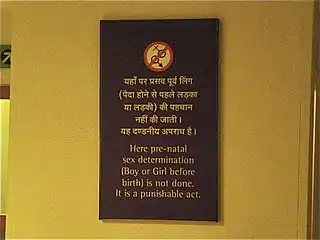Pre-Conception and Pre-Natal Diagnostic Techniques Act, 1994
Pre-Conception and Pre-Natal Diagnostic Techniques (PCPNDT) Act, 1994 is an Act of the Parliament of India enacted to stop female foeticides and arrest the declining sex ratio in India. The act banned prenatal sex determination. Every genetic counselling centre, genetic laboratory or genetic clinic engaged in counselling or conducting pre-natal diagnostics techniques, like in vitro fertilisation (IVF) with the potential of sex selection (Preimplantation genetic diagnosis) before and after conception comes under preview of the PCPNDT Act and are banned.[1][2][3]
| The Pre-Conception Pre-Natal Diagnostic Techniques Act, 1994 | |
|---|---|
 | |
| Parliament of India | |
| |
| Citation | Act No. 57 of 1994 |
| Enacted by | Parliament of India |
| Assented to | 20 September 1994 |
| Commenced | 1 January 1996 |
| Amended by | |
| The Pre-Conception and Pre-Natal Diagnostic Techniques (Prohibition Of Sex Selection) Act. 2003 | |
| Status: In force | |
Female foeticide in India
This process began in the early 1990 when ultrasound techniques gained widespread use in India. There was a tendency for families to continuously produce children until a male child was born.[4] Foetal sex determination and sex selective abortion by medical professionals has today grown into a Rs. 1,000 crore industry (US$ 244 million). Social discrimination against women and a preference for sons have promoted female foeticide in various forms skewing the sex ratio of the country towards men.[5] According to the decennial Indian census, the sex ratio in the 0–6 age group in India went from 104.0 males per 100 females in 1981, to 105.8 in 1991, to 107.8 in 2001, to 109.4 in 2011. The ratio is significantly higher in certain states such as Punjab and Haryana (126.1 and 122.0, as of 2001).[6]
Objectives
The main purpose of enacting the act is to ban the use of sex selection techniques after conception and prevent the misuse of prenatal diagnostic technique for sex selective abortions.
Definitions
Sex selection is any act of identifying the sex of the foetus and elimination of the foetus if it is of the unwanted sex.[7]
Salient features

Offences under this act include conducting or helping in the conduct of prenatal diagnostic technique in the unregistered units, sex selection on a man or woman, conducting PND test for any purpose other than the one mentioned in the act, sale, distribution, supply, renting etc. of any ultra sound machine or any other equipment capable of detecting sex of the foetus. Main provisions in the act are[8]
- The Act provides for the prohibition of sex selection, before or after conception.
- It regulates the use of pre-natal diagnostic techniques, like ultrasound and amniocentesis by allowing them their use only to detect :
- genetic abnormalities
- metabolic disorders
- chromosomal abnormalities
- certain congenital malformations
- haemoglobinopathies
- sex linked disorders.
- No laboratory or centre or clinic will conduct any test including ultrasonography for the purpose of determining the sex of the foetus.
- No person, including the one who is conducting the procedure as per the law, will communicate the sex of the foetus to the pregnant woman or her relatives by words, signs or any other method.
- Any person who puts an advertisement for pre-natal and pre-conception sex determination facilities in the form of a notice, circular, label, wrapper or any document, or advertises through interior or other media in electronic or print form or engages in any visible representation made by means of hoarding, wall painting, signal, light, sound, smoke or gas, can be imprisoned for up to three years and fined Rs. 10,000.
Compulsory registration
The Act mandates compulsory registration of all diagnostic laboratories, all genetic counselling centres, genetic laboratories, genetic clinics and ultrasound clinics.[4]
Amendment in 2003
Pre-Natal Diagnostic Techniques (Regulation and Prevention of Misuse) Act, 1994 (PNDT), was amended in 2003 to The Pre-Conception and Pre-Natal Diagnostic Techniques (Prohibition Of Sex Selection) Act (PCPNDT Act) to improve the regulation of the technology used in sex selection.
Implications of the amendment are
- Amendment of the act mainly covered bringing the technique of pre conception sex selection within the ambit of the act
- Bringing ultrasound within its ambit
- Empowering the central supervisory board, constitution of state level supervisory board
- Provision for more stringent punishments
- Empowering appropriate authorities with the power of civil court for search, seizure and sealing the machines and equipments of the violators
- Regulating the sale of the ultrasound machines only to registered bodies
References
- "Health ministry receives complaints against web giants for sex determination violations".
- "To ensure prized baby boy, Indians flock to Bangkok".
- "Chandigarh IVF expert helps police arrest Delhi resident seeking sex selection".
- "orissa gov. India" (PDF). Dr. Krushma chandra.
- "UNICEF India". UNICEF.
- Arnold, Fred, Kishor, Sunita, & Roy, T. K. (2002). "Sex-Selective Abortions in India". Population and Development Review. 28 (4): 759–785. doi:10.1111/j.1728-4457.2002.00759.x. JSTOR 3092788.CS1 maint: multiple names: authors list (link)
- "Answers to Frequently Asked Questions" (PDF). Pre-Conception and Pre-Natal Diagnostic Techniques (Prohibition Of Sex Selection) Act. Ministry of Health and Family Welfare, Government of India. Archived from the original (PDF) on 3 March 2016. Retrieved 27 June 2012.
- Goel, Ayush. "Preconception and prenatal diagnostic techniques act". Radiopaedia. Retrieved 28 May 2015.